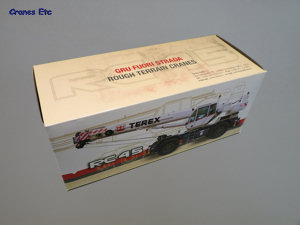 | | Terex picture box. |  | 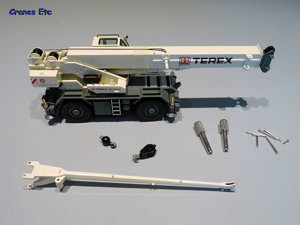 | | The parts out of the box, including two keys for operating the winches and plenty of pins. | 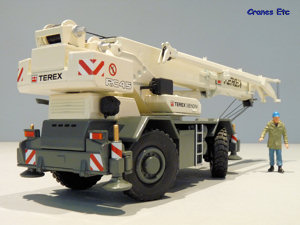 | | Excellent metal hubs on the wheels, and good lock on the steering. | 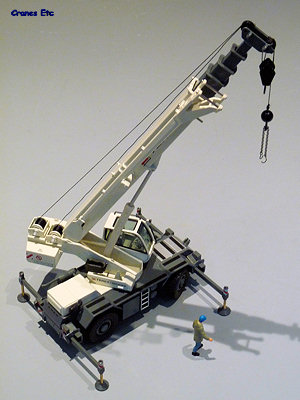 | | Set up and ready to lift. The lifting chains shown are not supplied with the model. | 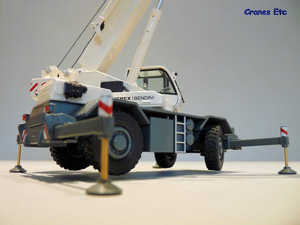 | | The outriggers can hold the crane off the ground. | 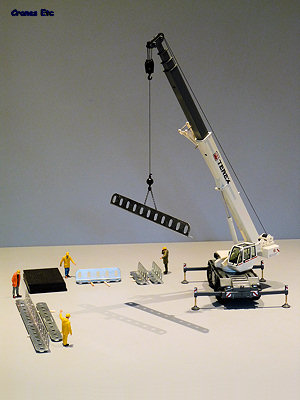 | | Lifting a lightweight beam. | 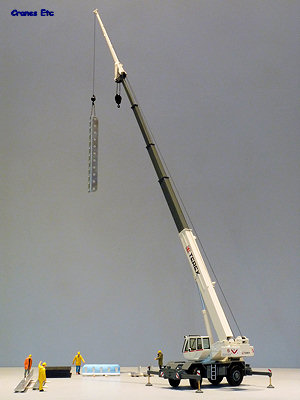 | | The boom is not quite fully extended in this photo. |
| Terex Bendini is a Terex brand based in Italy which is focussed on the production of rough terrain cranes.
he RC45 has a lifting capacity of 44t at 2.5m radius, and has a maximum extended boom length of 37.4m. It is capable of travelling at a maximum speed of 34km/h and its overall weight is 27.6t.
Packaging
The model comes in a Terex style box with a good quality photo on the outside although unfortunately there is no technical information about the real machine either on the box or provided as a separate inclusion. The crane is securely contained within two expanded polystyrene trays, and wrapped in tissue. There were no defects or missing parts on the review model.
Very little assembly is required other than to mount the fly jib using the pins supplied, and reeving the hooks. Two keys are supplied to operate the winches.
Detail
Underneath, the crane is reasonably detailed with the main drive shafts and suspension components visible. The rough terrain tyres are convincing with a good tread and they are mounted on metal hubs which include detailed wheel nuts.
The outrigger beams are simple, but are made of metal which is always nice to see. The jacks themselves are screw threads so are not the most realistic looking.
Each side of the carrier has a ladder for access to the cab and there is a fuel tank and other features detailed. The front and rear light clusters are represented by applied graphics which are adequate, and at the front there is an attachment point for a hook during transport. The top of the carrier has painted strips and there is a plastic exhaust arrangement (which has excellent colour match to the metal parts) and an air intake on the engine.
The operator's cab is pleasant with windscreen wipers, spotlight, door handle and a very nice grab rails. Inside, the main controls are visible.
The crane body is fairly simple, like the original, and the casting does include enough detail to provide interest. The applied graphics are very good including warning signs and the make and model name. Two winch drums are provided including the auxiliary drum which is an option on the real machine.
The boom is a five-section telescope with the base section having fly jib support brackets although the control cable drums are not modelled. Separate metal sheaves are provided in the boom head. The fly jib is a simple but effective casting.
Two hooks are provided and this provides welcome flexibility to the model. One is a single line headache ball and the other is a metal four sheave block which has a hook that rotates in its mounting and therefore provides options when the model is posed lifting.
Features
Both axles steer independently so all the steering modes of the real crane can be posed, including crab steering.
The outrigger beams pull out and can be set at half or full extension like the original. The pads screw down and with all the pads down it is possible to support the crane on the pads with the tyres clear of the ground.
All the usual crane functions can be operated. The crane rotates, and the boom can be raised and lowered. On the review model the hydraulic cylinders were stiff enough to hold the boom but just in case small pins are supplied and these can insert into the cylinder jacket to fix the boom angle. The telescoping sections pull out smoothly and have the usual locking mechanism at full extension.
The two winches can be operated with the supplied keys and the drums have enough friction to hold any reasonable load.
The fly jib can be pinned to the lowest boom section for transport, or can be pinned to the boom top to provide extra height of lift.
Quality
The castings are very good quality as usual for NZG and they are matched by the paintwork and graphics A few parts are plastic but these do not detract from the look of the model.
Price
The model is fairly priced for the quality offered.
Overall
This is a nice model representing a crane from one of the smaller Terex brands. It is well made and offers enough flexibility to be displayed in different ways. All things considered it is good enough to earn a highly recommended badge.
Footnotes
The model first appeared at the Nuremberg Toy Fair in 2008.
|
| |
| 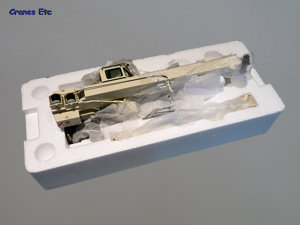 | | Inside the box. | 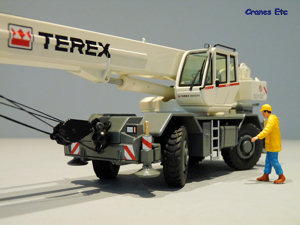 | | Good tyres and a place to hook onto whilst travelling. | 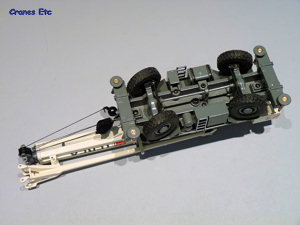 | | Underside view. | 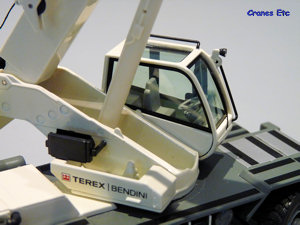 | | Close up of the cab. | 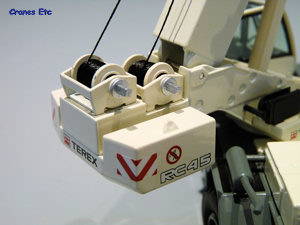 | | The two winch drums. | 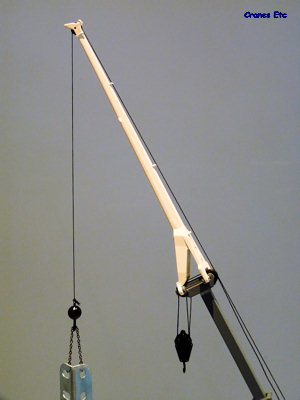 | | The fly jib attached and the two hooks. | 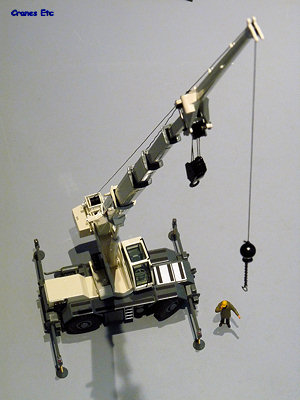 | | The boom is nice and straight when extended. | 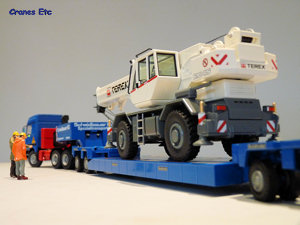 | | Travelling between sites on a Goldhofer Low Loader. |
|

